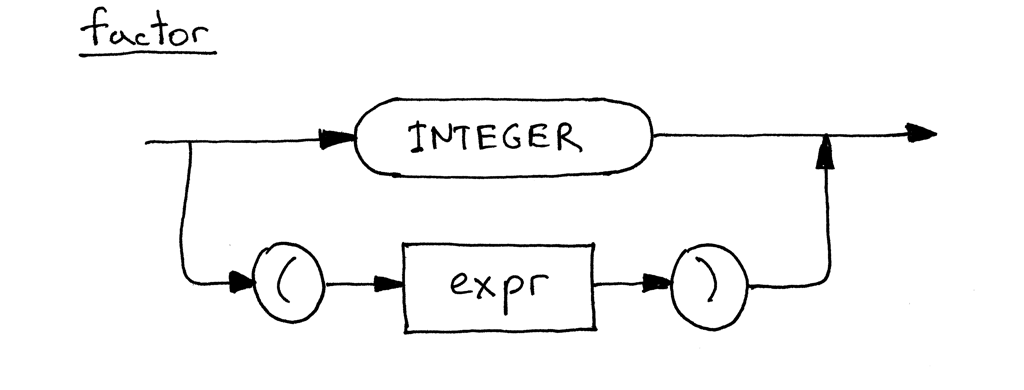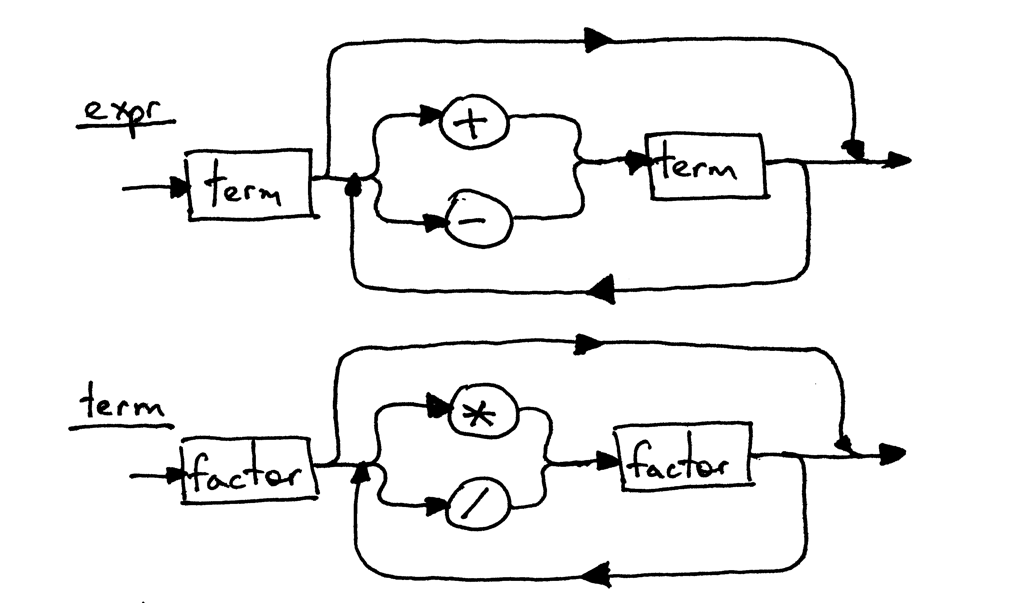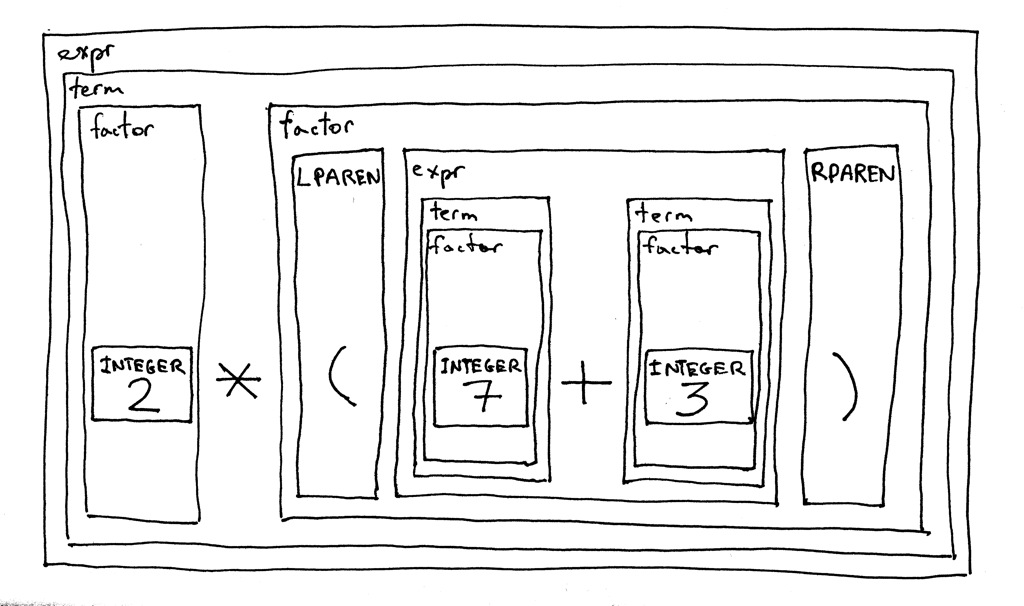原文:Let’s Build A Simple Interpreter. Part 6.
译文:
前言 今天是个重要的日子 :) 你可能会问:“为什么?” 因为今天我们将几乎完成对算术表达式的讨论,新增了括号表达式的支持,并且实现了一个能够解析任意深度嵌套括号表达式的解释器。比如表达式 7 + 3 * (10 / (12 / (3 + 1) - 1))。
更新语法 首先,我们需要修改语法以支持括号内的表达式。如你所记得的第五部分,factor 规则用于表达式中的基本单元。在那篇文章中,唯一的基本单元是整数。今天我们要添加另一种基本单元——括号表达式。
以下是我们更新后的语法:
expr 和 term 的生成规则与第五部分完全相同,唯一的变化是 factor 生成规则,LPAREN 表示左括号 '(',RPAREN 表示右括号 ')',括号中的非终结符 expr 指代 expr 规则。
这是更新后的 factor 语法图,现在它包含了多个选项:
由于 expr 和 term 的语法规则没有变化,它们的语法图与第五部分保持一致:
我们的新语法有一个有趣的特性——它是递归的。如果你推导表达式 2 * (7 + 3),你将从 expr 开始符号开始,并最终递归地使用 expr 规则推导出 (7 + 3) 部分。
让我们根据语法分解表达式 2 * (7 + 3),看看它的结构:
如果你需要复习递归知识,可以参考 Daniel P. Friedman 和 Matthias Felleisen 的《The Little Schemer》 一书,这本书非常不错。
实现代码 接下来,让我们将更新后的语法转换为代码。
以下是对前一篇文章中的代码的主要修改:
Lexer 类新增了两个 token:LPAREN 表示左括号,RPAREN 表示右括号。Interpreter 类的 factor 方法更新,支持解析括号表达式和整数。
以下是一个完整的计算器代码,它可以解析包含整数、任意数量的加减乘除运算符,以及任意深度嵌套括号表达式的算术表达式:
1 2 3 4 5 6 7 8 9 10 11 12 13 14 15 16 17 18 19 20 21 22 23 24 25 26 27 28 29 30 31 32 33 34 35 36 37 38 39 40 41 42 43 44 45 46 47 48 49 50 51 52 53 54 55 56 57 58 59 60 61 62 63 64 65 66 67 68 69 70 71 72 73 74 75 76 77 78 79 80 81 82 83 84 85 86 87 88 89 90 91 92 93 94 95 96 97 98 99 100 101 102 103 104 105 106 107 108 109 110 111 112 113 114 115 116 117 118 119 120 121 122 123 124 125 126 127 128 129 130 131 132 133 134 135 136 137 138 139 140 141 142 143 144 145 146 147 148 149 150 151 152 153 154 155 156 157 158 159 160 161 162 163 164 165 166 167 168 169 170 171 172 173 174 175 176 177 178 179 180 181 182 183 184 185 186 187 INTEGER, PLUS, MINUS, MUL, DIV, LPAREN, RPAREN, EOF = ( 'INTEGER' , 'PLUS' , 'MINUS' , 'MUL' , 'DIV' , '(' , ')' , 'EOF' ) class Token (object ): def __init__ (self, type , value ): self.type = type self.value = value def __str__ (self ): """类实例的字符串表示。 示例: Token(INTEGER, 3) Token(PLUS, '+') Token(MUL, '*') """ return 'Token({type}, {value})' .format ( type =self.type , value=repr (self.value) ) def __repr__ (self ): return self.__str__() class Lexer (object ): def __init__ (self, text ): self.text = text self.pos = 0 self.current_char = self.text[self.pos] def error (self ): raise Exception('无效字符' ) def advance (self ): """前进 `pos` 指针并设置 `current_char` 变量。""" self.pos += 1 if self.pos > len (self.text) - 1 : self.current_char = None else : self.current_char = self.text[self.pos] def skip_whitespace (self ): while self.current_char is not None and self.current_char.isspace(): self.advance() def integer (self ): """返回从输入中提取的多位整数。""" result = '' while self.current_char is not None and 她self.current_char.isdigit(): result += self.current_char self.advance() return int (result) def get_next_token (self ): """词法分析器(也称为扫描器或标记器) 该方法负责将句子分解为 token,每次一个。 """ while self.current_char is not None : if self.current_char.isspace(): self.skip_whitespace() continue if self.current_char.isdigit(): return Token(INTEGER, self.integer()) if self.current_char == '+' : self.advance() return Token(PLUS, '+' ) if self.current_char == '-' : self.advance() return Token(MINUS, '-' ) if self.current_char == '*' : self.advance() return Token(MUL, '*' ) if self.current_char == '/' : self.advance() return Token(DIV, '/' ) if self.current_char == '(' : self.advance() return Token(LPAREN, '(' ) if self.current_char == ')' : self.advance() return Token(RPAREN, ')' ) self.error() return Token(EOF, None ) class Interpreter (object ): def __init__ (self, lexer ): self.lexer = lexer self.current_token = self.lexer.get_next_token() def error (self ): raise Exception('语法错误' ) def eat (self, token_type ): if self.current_token.type == token_type: self.current_token = self.lexer.get_next_token() else : self.error() def factor (self ): """factor : INTEGER | LPAREN expr RPAREN""" token = self.current_token if token.type == INTEGER: self.eat(INTEGER) return token.value elif token.type == LPAREN: self.eat(LPAREN) result = self.expr() self.eat(RPAREN) return result def term (self ): """term : factor ((MUL | DIV) factor)*""" result = self.factor() while self.current_token.type in (MUL, DIV): token = self.current_token if token.type == MUL: self.eat(MUL) result *= self.factor() elif token.type == DIV: self.eat(DIV) result /= self.factor() return result def expr (self ): """算术表达式解析器 / 解释器。 calc> 7 + 3 * (10 / (12 / (3 + 1) - 1)) 22 expr : term ((PLUS | MINUS) term)* term : factor ((MUL | DIV) factor)* factor : INTEGER | LPAREN expr RPAREN """ result = self.term() while self.current_token.type in (PLUS, MINUS): token = self.current_token if token.type == PLUS: self.eat(PLUS) result += self.term() elif token.type == MINUS: self.eat(MINUS) result -= self.term() return result def main (): while True : try : text = raw_input('calc> ' ) except EOFError: break if not text: continue lexer = Lexer(text) interpreter = Interpreter(lexer) result = interpreter.expr() print (result) if __name__ == '__main__' : main()
示例会话 将以上代码保存为 calc6.py
以下是一个示例会话:
1 2 3 4 5 6 7 8 9 10 11 12 13 14 15 $ python calc6.py calc> 3 3 calc> 2 + 7 * 4 30 calc> 7 - 8 / 4 5 calc> 14 + 2 * 3 - 6 / 2 17 calc> 7 + 3 * (10 / (12 / (3 + 1) - 1)) 22 calc> 7 + 3 * (10 / (12 / (3 + 1) - 1)) / (2 + 3) - 5 - 3 + (8) 10 calc> 7 + (((3 + 2 ))) 12
练习与总结 今天为你准备的新练习:
编写你自己的算术表达式解释器,如本文所述。记住:重复是学习之母。
恭喜你,你一直读到最后!你已经学会了如何创建(如果你完成了练习——你实际上已经编写了)一个基本的递归下降解析器/解释器,它能够解析复杂的算术表达式。
在下一篇文章中,我将更详细地讨论递归下降解析器 。我还将介绍一种在解释器和编译器构建中非常重要且广泛使用的数据结构,我们将在整个系列中使用它。
敬请期待,下次见。在那之前,继续完善你的解释器,最重要的是:享受过程,尽情享受吧!
推荐书籍 以下是我推荐的几本书,它们将帮助你学习解释器和编译器:




